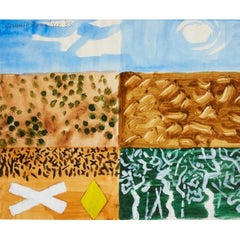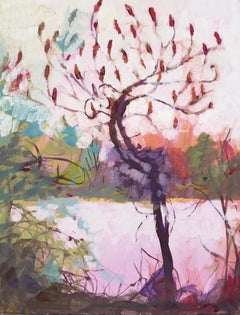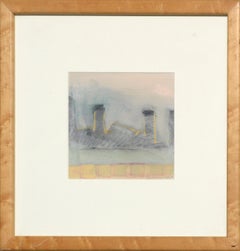Kenneth Rowntree Abstract Drawings and Watercolors
Kenneth Rowntree was born in Scarborough on March 14, 1915, and educated in York where his father managed the local department store. Young Kenneth’s work was displayed there and his first major commission arose from an advertisement at the store. After studying at the Ruskin School of Drawing in Oxford, he went on to study at the Slade School. At the Slade School, he met Eric Ravilious and Edward Bawden and then moved to north Essex to work with them as members of the group of Great Bardfield Artists. Between 1940–43, he was one of the teams of over 60 artists engaged by the War Artists’ Advisory Committee for the Recording Britain project, to record the face of England and Wales before wartime action or before development changed it forever. Rowntree’s keen sense of design and fascination with the quirky and the vernacular made him an ideal candidate to interpret our built heritage’s more unusual aspects. In 1951, he painted murals in the Lion and Unicorn Pavilion for the Festival of Britain and he decorated the route of the Queen’s Coronation procession. During a teaching job at the Ruskin School of Drawing in Oxford he was driven, perhaps by his experiences recording Britain, to record the decorated barges that belonged to the Oxford Colleges. These wooden Victorian ceremonial barges had belonged to the London livery companies but were acquired in their later life by the Colleges to be used as changing rooms and clubhouses for the College boat clubs. Partway through painting one of them, Rowntree thought his drawing was incorrect until he realized that it was the boat that was moving. It was in fact sinking. In 1959, he was appointed Professor of Fine Art at Newcastle University, which as British art schools went was one of the most progressive. The Master of Painting was the abstract constructionist Victor Pasmore, and his assistant the father of British pop art, Richard Hamilton. Also Master of Sculpture was John Robert Murray McCheyne. In this environment Rowntree became receptive to assemblage and constructivism and other modernist idioms, incorporating them into his own work. Kenneth Rowntree worked with the architect Ernő Goldfinger to produce colored glass panels in Goldfinger’s Alexander Fleming House in the Elephant and Castle. He died in Hexham on February 21, 1997.
Late 20th Century Abstract Kenneth Rowntree Abstract Drawings and Watercolors
Watercolor
2010s Abstract Impressionist Kenneth Rowntree Abstract Drawings and Watercolors
Paper, Gouache
1990s Abstract Impressionist Kenneth Rowntree Abstract Drawings and Watercolors
Paper, Pastel, Watercolor
1970s Abstract Geometric Kenneth Rowntree Abstract Drawings and Watercolors
Watercolor, Archival Paper, Rag Paper
1960s Abstract Expressionist Kenneth Rowntree Abstract Drawings and Watercolors
Watercolor, Tissue Paper
1960s Abstract Expressionist Kenneth Rowntree Abstract Drawings and Watercolors
Paper, Watercolor
1950s Abstract Kenneth Rowntree Abstract Drawings and Watercolors
Paper, Gouache
1980s Abstract Expressionist Kenneth Rowntree Abstract Drawings and Watercolors
Paper, Watercolor
1980s Abstract Impressionist Kenneth Rowntree Abstract Drawings and Watercolors
Paper, Watercolor
1990s Abstract Expressionist Kenneth Rowntree Abstract Drawings and Watercolors
Ink, Watercolor, Permanent Marker
Mark di SuveroProject for Sculpture in Chalon-sur-Saône (unique sculptural drawing for France), 1992
1960s Abstract Kenneth Rowntree Abstract Drawings and Watercolors
Watercolor
2010s Abstract Impressionist Kenneth Rowntree Abstract Drawings and Watercolors
Paper, Gouache, Color Pencil
1980s Abstract Expressionist Kenneth Rowntree Abstract Drawings and Watercolors
Paper, Watercolor


